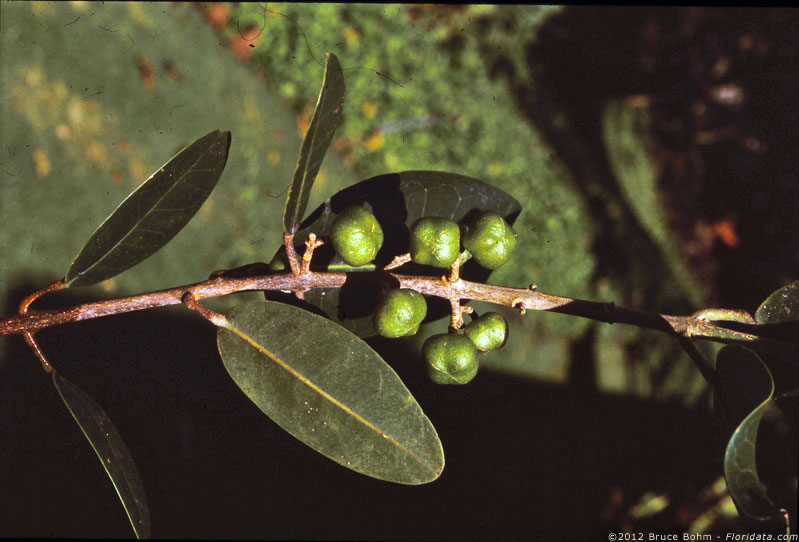



The large cosmopolitan family Rutaceae, which is well represented on the islands, consists of about 1,900 species arrayed in 158 genera. The most familiar genus in the family would likely be Citrus. The Hawaiian Islands have no native species of Citrus, but there is some cultivation of C. reticulata, the tangerine. Ruta graveolens, garden rue, would be well known to gardeners.
One of the larger genera in the Hawaiian flora, with 47 species, began its botanical life as Pelea, named after the Hawaiian Goddess of fire Pele (not Pelé, the Brazilian football genius). According to at least one source, Pele was also in charge of volcanoes (which shouldn't be surprising), dance, and violence–a busy lady indeed. Recent investigation of the species that comprise Pelea revealed that the genus falls within the boundaries of the larger genus Melicope. The larger genus–233 species–has representatives ranging from Madagascar to New Zealand and islands in the Pacific Basin. Although this change resulted in the loss of the Hawaiian endemic genus Pelea, the islands' species still count among the list of endemics, and in fact comprise an endemic section within the genus, hence Melicope sect. Pelea. Of the nearly four dozen species on the islands, more than half are either rare and/or endangered; three are possibly extinct, known only from their respective type collections.
The most well known species is Melicope anisata (see image), known in Hawaiian as mokihana (or mokehana). The fruits of mokihana were, and continue to be, extremely popular owing to their rich anise aroma (hence anisata). Plant parts were used to scent kapa cloth, and the fruits were strung together to make leis. It is the official lei plant of the island of Kaua`i, on which island it is endemic. There is a risk associated with wearing a mokihana lei, however. Contact with the skin can cause a rash, sometimes severe, when the contact area is exposed to sunlight; sensitivity varies widely among individual lei wearers. The phenomenon, known as photosensitization, occurs when sunlight catalyzes a reaction between molecules of the active chemicals in the mokihana fruit and sulfur-rich proteins in the skin yielding a product that the body recognizes as foreign and against which the reaction is aimed. The structures of the offending molecules, a group of furanocoumarins, were described in 1985 by Y. Marchant and coworkers in the Department of Botany at the University of British Columbia. The main odor component was identified as anisaldehyde (4-methoxybenzaldehyde) by Paul Scheuer (1955; see also Scheuer and Hudgin, 1964). This compound is not one of the photoactive molecules.
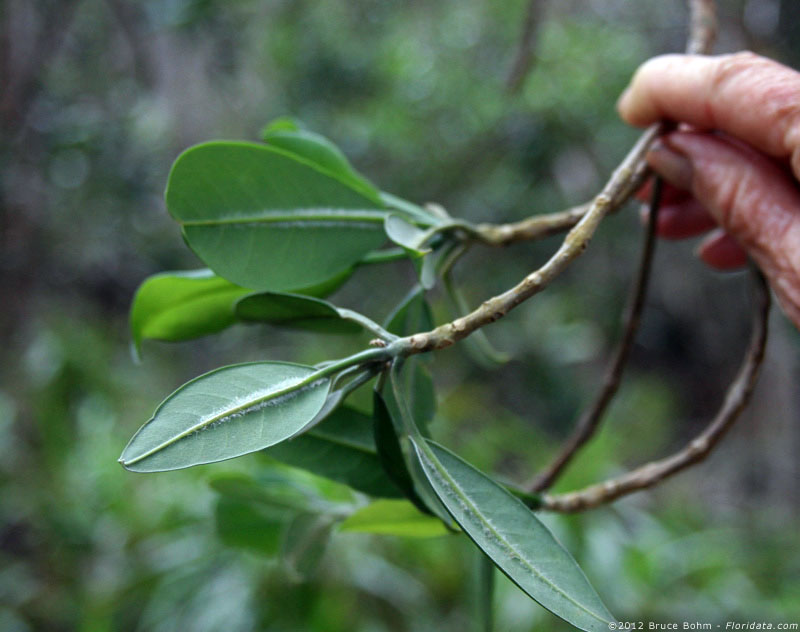
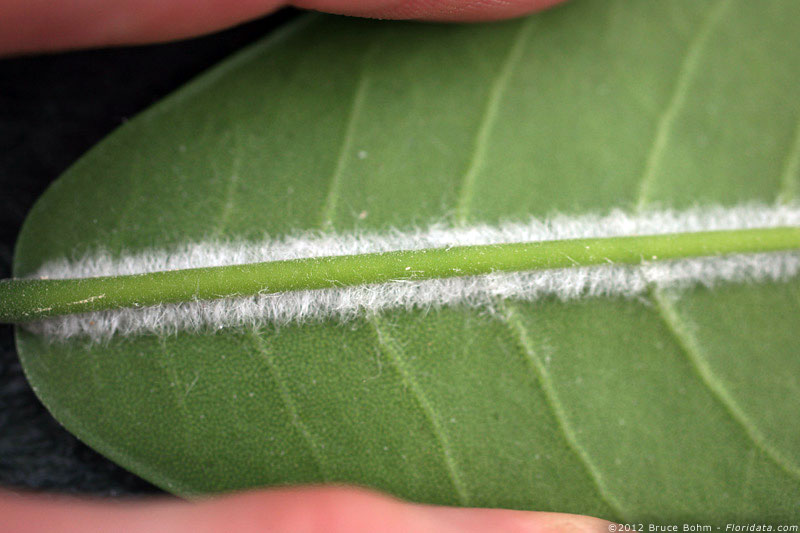
The most widespread species of Melicope on the islands is M. clusiifolia (see image), which occurs in mesic to wet forests on all islands except Ni`ihau and Kaho`olawe, both of which are too dry. It is also a variable species, but the rolled leaves of the plant, and the characteristic anise aroma–weaker than mokihana but definitely detectable–together provide useful identifying features. The plant in the photograph was growing beside the boardwalk on the Pihea Trail (Kaua`i). The Hawaiian name for this species is kolokolo mokihana, where kolokolo refers to the creeping habit of a plant. Another name for this species, apparently used only on Kaua`i, is kükaemoa, which on literal translation is a bit disturbing; the word means excrement of chicken. After going on about the lovely aroma of these species it is, frankly, disturbing to think that some folks–at least on Kaua`i–think that it smells of chicken, ah, droppings. Not to worry; the reference is to the appearance of the seed capsules. I should add that all species of Melicope are known in general by the name alani or alani kuahiwi (kuahiwi is hill or mountain, hence alani from higher elevation sites). A species endemic to Kaua`i is M. barbigera (see image), known as an alani in general but specifically as uahiapele. Uahi is the Hawaiian word for smoke in reference to the smoky-gray color of the leaves, hence, Pele's smoke. A characteristic feature of this species are the soft hairs that grow along the midrib on the under sides of leaves (see image).

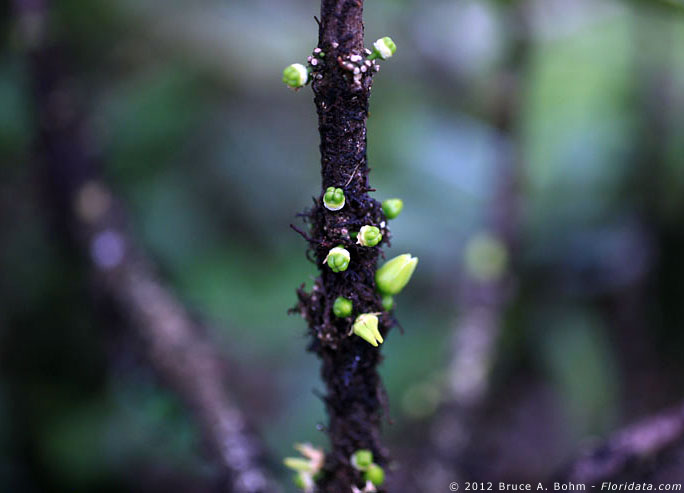
Melicope munroi (see image) is one the species designated as rare; it occurs only at higher elevations on Läna`i in the vicinity of Läna`ihale. On my first visit to the area I recognized the plant as possibly belonging to Melicope because of the characteristic four-part fruits emerging directly from the main stem (see image), but the lack of an anise aroma suggested that I might be wrong, although there are species of Melicope that lack the aromatic compound. On a return visit to the general area, this time with a knowledgeable companion, another specimen was located in an area where native plants were marked by tags to distinguish them from alien species that were being cleared. The shrub in question was identified on its plastic tag as alani. Re-sniffing revealed a hint of anise.
Platydesma, a genus consisting of four species, is endemic to the Hawaiian Islands. Platydesma spathulata (see image) is the most widespread of the four, occurring on Kaua`i, O`ahu, Maui, and on the Big Island. The other three species are limited to a single island each. Authors of the Manual stated that the genus is the result of a single colonization event and that it is independent of other Hawaiian members of Rutaceae. A recently published study by Danica Harbaugh and her colleagues at the Smithsonian Institution (2009), however, describes a new set of data that required a reassessment of the status of Platydesma.
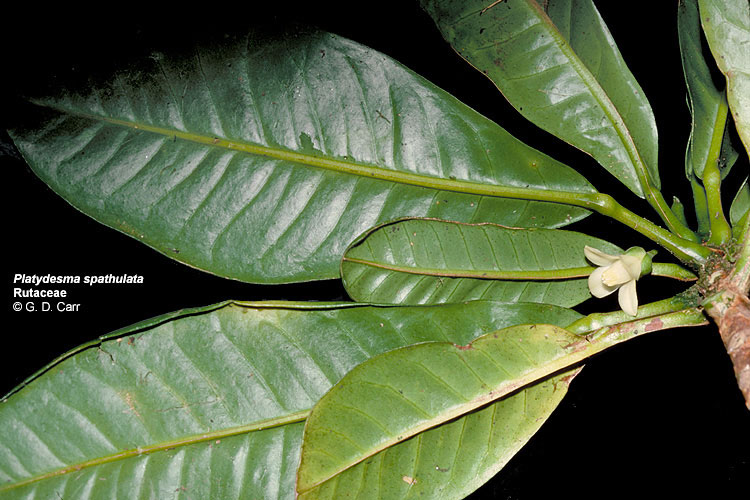
The study involved species of Melicope from the Hawaiian Islands, the Marquesas Islands, Tahiti, Australia, and Lord Island, two species of Platydesma, and as well as two related genera for comparison. The first conclusion arising from the study was that the species of Platydesma properly belong within Melicope; in other words, there is no support for recognizing Platydesma as a distinct genus (its taxonomic recognition as a unique group within Melicope is a possibility, but that doesn't affect our story here). The second major conclusion, and quite possibly the more important one, is that at least one of the Marquesan species has been derived from a Hawaiian progenitor. This adds to the increasing number of examples of the Hawaiian Islands serving as a source of propagules, as well as a sink.



Our final look at the family brings us the genus Zanthoxylum for which Hawaiians have three names: a`e, mänele, and hea`e. The genus consists of about 200 species according to Mabberley's reckoning (p. 920), or as many as 275 according to the Manual. The majority of the species are Asian and Australian but there is a representative in eastern North America (Z. americanum). Four endemic species are known in the Hawaiian Islands Z. dipetalum, which is known in Hawaiian as käwa`u, käwa`u kua kuku kapa, occurs on all of the main islands except Läna`i, Maui, Ni`ihau, and Kaho`olawe; Z. hawaiiense (see images), which can be found on Moloka`i, Läna`i, Maui, and Hawai`i, and is considered endangered; Z. kauaense, which occurs on all of the main islands except Ni`ihau and Kaho`olawe; and Z. oahuense (see image), which is found only in the Ko`olau Mountains on O`ahu. The Hawaiian name for Z. dipetalum deserves some comment. Käwa`u is the name for the species itself while the words kua and kuku refer to chopping and beating, respectively, steps in the production of kapa, the cloth made from wauke (Broussonetia) fibers. Logs of this species were favored as anvils on which the plants were beaten. The logs were also used as drums for sending messages over long distances.
The Hawaiian species of Zanthoxylum attracted the attention of workers at the University of Hawai`i who were interested in reports that other members of the genus had been reported to possess insecticidal properties (Marr and Tang, 1992). One of the driving forces for studies of this sort is the possibility of finding effective naturally occurring agents that are not toxic to humans and animals as well. Several of the hexane-soluble components of the Zanthoxylum extracts, or their mixtures, exhibited useful insecticidal properties, but the level of variation observed among individuals, even within the same population, was unexpected making interpretation of the results difficult. The level of variation was of interest in another context, however. The reader may recall the extreme variation in flavonoid pigment composition within populations of Bidens (Part 5), and that this was in stark contrast to nearly constant profiles that were observed in Vaccinium, Metrosideros, and Wilkesia.
Literature cited…
Harbaugh, D. T., W. L. Wagner, G. J. Allen and E. A. Zimmer. 2009. The Hawaiian Archipelago is a stepping stone for dispersal in the Pacific: an example from the plant genus Melicope (Rutaceae). Journal of Biogeography 36: 230-241. DOI:10.1111/j.1365-2699.2008.02008.x
Marchant, Y., M. Turjman, T. Flynn, F. Balza, J. C. Mitchell and G. H. N. Towers. 1985. Identification of psoralen, 8-methoxypsoralen, isopimpinellin, and 5,7-dimethoxycoumarin in Pelea anisata H. Mann. Contact Dermatitis 12: 196-199.
Marr, K. L. and C. S. Tang. 1992. Volatile insecticidal compounds and chemical variability of Hawaiian Zanthoxylum (Rutaceae) species. Biochemical Systematics and Ecology 20: 209-217.
Scheuer, P. J. 1955. The constituents of mokihana (Pelea anisata). Chemistry & Industry 1257-1258.
Scheuer, P. J. and W. R. Hudgin. 1964. Major constituents of the essential oil of Pelea christophersenii. Perfumery and Essential Oil Record 55: 723-724.
August 27, 2012